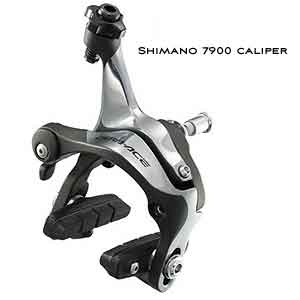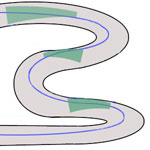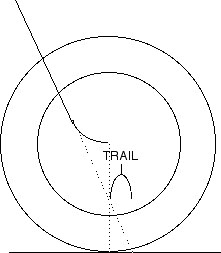Want to speed up? Slow down

Steve Hed and I were lamenting last night about how the pro bike, as an art form, is dead. Now, you might argue this point, and even if you don't you might say: "So what? If we lost the "art" of the pro bike at least we still have the 'science' of it!"
No, you don't. What you have is the industrialization of it.
The ways in which the pro bike has devolved are legion, and I'll just mention a couple. Back in the 70s I could buy and ride handmade tubular tires you just can't buy today. You might argue that it does not matter, because today's clinchers are the equal of tubulars. Yes, that's true, today's clinchers are the equal of today's tubulars. But if you're comparing today's tubies to a 220g Clement Criterium Seta Extra, well, that's like equating Pam Anderson with Marilyn Monroe.
And how about forks? Yes, today's forks are 350g compared to forks in the 70s that weighed four or five times that much. But, the blades on those forks were hand-bent by your bike maker. They were precise to a degree you aren't likely to find today. Your bike has speed wobble, your bike handles badly, your bike and you are not a unit, because of the many axes that today's forks can be built with imprecision. Add to that my informal poll of several dozen of the bike industry's professionals, three-fourths of whom maintain that adding fork offset slows a bike's steering down, when it actually speeds it up.
I have no one to blame but myself. Perhaps the biggest blow to the "pro bike" was struck in the early 90s. Did I invent trash spec? I can't be sure if I was the first, but I think I was. I plead guilty with an explanation. Back then, Shimano had seven levels of OE pricing, and mine was small framebuilder pricing. I'll leave it up to you to guess where along that gradient of high-to-low my pricing lay. Today, Shimano treats bike makers large and small with relative equality. But the damage was done and I did it.
Back then, I decided that a Shimano Dura Ace bike was a bike on which the parts clearly read Dura Ace, specifically, front and rear derailleur. I had a variety of ways to go about getting other pretty good parts on the cheap, and my bikes worked reasonably well. But a Dura Ace bottom bracket, chain, cassette, never got near my bike. I trod on the concept of the "gruppo," and when I continued to sell bikes the rest of the tri industry (and now the road industry) was very happy to adopt my blasphemous gospel.
One of my regrets is today's disdain for brake calipers, brake levers, and stopping power. The designs of today's bikes, brakes, pursuit bars, and frame geometries cost mountains of time for those athletes who don't know any better. Let's me qualify this:
Brake calipers
In the early 90s, I spec'd "Shimano dual pivot brakes" on my bikes. I said it right there in the spec sheet. What I omitted telling my customers was what dual pivot brake. Why? Because brake caliper prices were killing me. So, I spec'd the cheapest caliper I could; I made sure it bore no recognizable identifier other than "Shimano"; and that was that. From that day 'til this, brake calipers have been a casualty.
Until you've ridden a really good caliper, with a high quality brake pad, properly adusted; not worn down and full of grease and metal flakes; good levers; and a round rim, true with a quality, planar braking surface; it's like the old Clement silk tubular: You just don't know how good good can be. If you pair this equipment with the knowledge of how to brake, corner and descend fast, you can take valuable time out of your competitors.
Brake levers
For years, the only plug-in brake lever we had was the Dia Compe #188. I found this lever in Germany, in 1990, stuck into the bars ends of a $300 upright commuter bike. I imported the lever and placed it as original equipment on our tri bikes (they plugged into the ends of pursuit bars). Ten years and two Tour de France wins later these $2 levers were still the only pursuit levers out there. Finally, today, we have many levers to choose from, all good ones, all with return springs. Profile Design, SRAM, Tektro, and others make them. You do have such a set of levers on your bike, right?
Pursuit bars
The problem is not so much whether they have an upturn at the end of the contact point, though many folks find this useful. I can successfully and quickly decelerate using a Hed 1pc aerobar, or a 3T Ventus, each of which has a minimalist pursuit position. More important is no, or minimal, elevation drop from the handlebar/stem clamp, and the lack of forward protrusion. Each of these no-nos puts too much weight on the front wheel, and adds too much steering "lever." Probably the best pursuit position going is on Zipp's Vuka bar. There are things I don't admire about that bar, but the pursuit position is ideal.
Frame geometry
Pay attention to a bike's front/center measure. A Kestrel Airfoil Pro in its 59cm size has a front/center of about 63cm. Kestrel's Talon SL Tri in 60cm has a front/center between 60cm and 61cm. That 2cm+ difference may not seem like much, but stopping power on a descent is largely determined by weight displacement. A 60cm tri bike ought to have a front/center more like the Airfoil Pro, and even 1cm or 2cm more is acceptable and perhaps desired. Furthermore, the Talon in that size has 51mm of "trail." The more trail, the more stable a bike will ride, and you want stability on tri bikes, which are literally "front-end loaded," especially as you brake on a descent. The Airfoil Pro has 54mm of trail, and even that is on the lean side (I prefer the 61mm and 62mm of trail in the Airfoil Pro's 50cm and 52cm bikes).
Technique
This is the biggie. Look, every article that piques your interest, every forum thread that tickles your fancy, is about how to increase your top speed. In 10 years of publishing Slowtwitch, I've yet to see a discussion on the forum about how to artfully decrease your speed. But if this were a site for motorheads, or café racers, you bet brakes would be a point of discussion. And, of course, this is free speed. It's just a matter of good equipment and proper technique, not of better physiology or power-to-weight ratios.
At the bottom of this article is a link to a primer on descending. You'll note that pro bike racers cut the tangent of the roads they descend. I don't advocate that. You'll also note that these pro bike racers in grand tours get to use the entire road, which is closed to traffic; and that in every tour at least one of them tumbles down the mountain after not making the turn (notwithstanding their ability to use the entire road).
I was riding in the Santa Monica Mountains with several industry folk last year. We were descending fast down Mulholland Highway, and two of the fellows just didn't make a pair of blind, right-hand turns. Well, they made their turns, just not before crossing the double yellow and ending up in the middle of oncoming traffic. Fortunately, there were no oncoming cars at that moment. These folks used the "cutting the tangent" method, but this leaves no room for error.
I am a careful, yet relatively fast, descender. I calculate my braking distance based on safety, and speed, and in the sure knowledge of my equipment. I'm quite confident that I get some multiples of the speed of an aero helmet just out of my ability to safely decelerate better than those in my competitive set. In fact, you might say brake calipers are worth more time than an aero helmet. But they aren't calipers made by Zero Gravity or Feather Brakes, rather they're simply high quality calipers with stopping power. This is not to say that these two highly regarded lightweight brake caliper makers don't stop your bike appropriately, rather that weight is the secondary issue when it comes to the speed a good brake caliper gives you.



